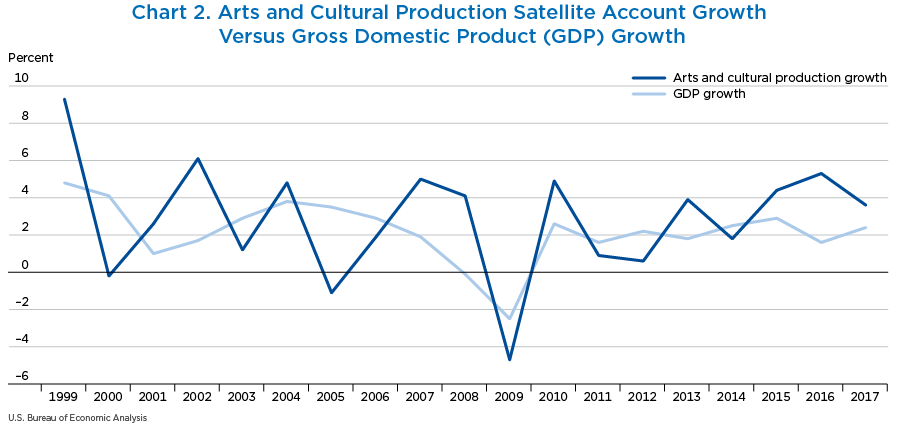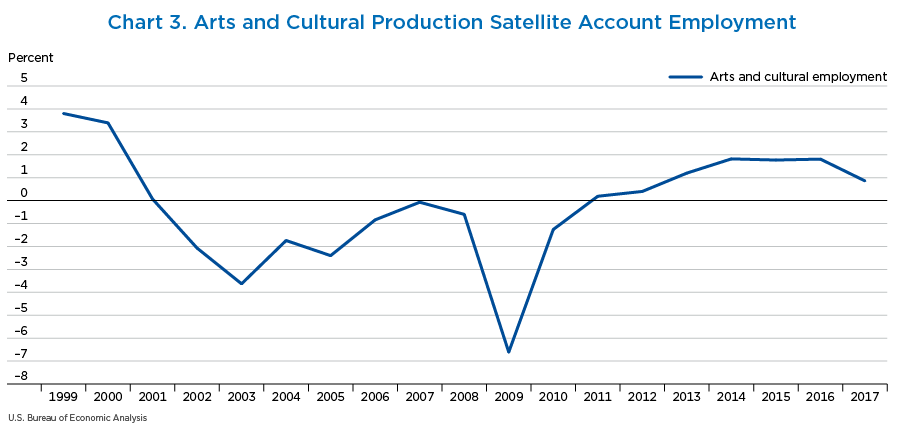Arts and Cultural Production Satellite Account
New Statistics for 2017 and Updated Statistics
The Bureau of Economic Analysis (BEA) released national and state-level estimates for the Arts and Cultural Production Satellite Account (ACPSA) on March 17, 2020. This release updated the estimates between 1998 and 2016 and introduced new estimates for 2017. This article discusses the revised and newly released value added, employment, and compensation statistics in the ACPSA.
For the nation, value added for the arts and cultural production industries increased 3.6 percent in 2017 to $827 billion after increasing 5.3 percent in 2016. Information and design services were the leading contributors to growth. Arts contributed 4.5 percent nationally to current-dollar gross domestic product (GDP) in 2017. This contribution to GDP was larger than many other industries in the U.S. economy, including transportation and warehousing services and construction.
Employment in the arts and cultural production industries totaled 5.1 million jobs and grew 0.9 percent in 2017, following an increase of 1.8 percent in 2016. Compensation in the arts and cultural production industries grew 4.7 percent in 2017, after increasing 3.2 percent in 2016 (chart 1).
BEA’s satellite accounts, which expand on the Input-Output Accounts, focus on sectors of economic activity not explicitly defined in the standard accounts. BEA currently produces satellite accounts for several sectors, including travel and tourism, health care, outdoor recreation, and arts and cultural production. The ACPSA was first produced for the United States in 2013, and since then, the account has expanded to provide estimates adjusted for price change and for the 50 states and the District of Columbia.1
In producing this satellite account, BEA used a conservative approach and focused on creative artistic activity, the goods and services produced by it, the goods and services produced in support of it, and the construction of the buildings in which it takes place. The BEA supply-use tables (SUTs) allow us to value each link in this creative chain.
The core category includes the commodities in which output is identified as primarily contributing to arts and culture; it includes performing arts, museums, design services, and arts education. The supporting category consists of the commodities that support the core category through publication, dissemination of the creative process, or other supportive functions; for example, it includes event promotion, printing, and broadcasting. An example to illustrate the difference between the core industries and the supporting industries is a performance by a musical group, viewed live in an auditorium, and also recorded for later dissemination as a digital recording. The composition of the music, and the performance of it, would be identified as core industries. Then, the recording of the concert, the production of the resulting digital media, the selling of tickets to the event, the publication of the program, and even the construction of the concert hall would be identified as supporting industries.
On November 1, 2018, BEA released revised estimates for 1997–2016 and introduced estimates for 2017 for GDP by industry. The accounts provide statistics on the interactions between industries and each industry’s contribution to GDP. Additionally, the 2012 SUTs were released and the 2007 SUTs were updated. These tables provided a detailed view of the relationships among the industries and commodities used to estimate GDP. The ACPSA statistics were also updated to reflect these revised industry statistics.
Comprehensive updates occur every 5 years and differ from annual updates in the scope of improvements as well as the number of years impacted. The 2018 comprehensive update introduced three improvements: (1) integration with the 2012 benchmark SUTs and the 2018 comprehensive update of the National Income and Product Accounts, (2) changes in the definitions and classifications, which update the accounts to more accurately portray the dynamic U.S. economy, and (3) statistical changes, which update the accounts through the use of new and improved estimation methods and newly available and revised source data, most notably the Economic Census, which is used to benchmark the accounts.
The value-added statistic measures an industry’s contribution to GDP. In 2017, the arts and cultural production industries contributed 4.5 percent nationally to current-dollar GDP. The 4.5 percent contribution was larger than many industries within the economy, including transportation and warehousing services, which contributed 3.1 percent, and construction, which contributed 4.0 percent.
Real value added for the arts and cultural production industries was $826.9 billion in 2017, increasing 3.6 percent from $798.3 billion in 2016 (chart 2), while GDP increased 2.3 percent in 2017. The core industries group increased 2.7 percent in 2017, contributing $163.2 billion to the overall total, and the supporting group grew 4.0 percent, adding $643.9 billion to the total.
Overall, total ACPSA employment in the United States grew 0.9 percent to 5.11 million jobs in 2017, which accounted for 3.4 percent of total employment in the United States (chart 3). This increase represents a continuing 7-year trend of U.S. employment increases in the ACPSA. Both core arts and supporting arts contributed to the increase, growing 2.1 percent and 0.5 percent, respectively. The core arts and cultural production industries added 1.2 million jobs, while the supporting arts and cultural production industries added 3.7 million jobs to the overall U.S. total in 2017.
Compensation for the arts and cultural production industries was $404.8 billion in 2017, increasing 4.7 percent from $386.8 billion in 2016. The arts and cultural production industries accounted for 4.8 percent of total national compensation. The average compensation for an ACPSA employee was $79,259, increasing 3.8 percent from the previous year.
Compensation in the core arts and cultural industries grew 4.7 percent in 2017, with an average compensation of $65,740 per employee. In 2017, compensation in the supporting industries grew 4.7 percent, with the average compensation in the supporting industries equal to $84,221 per employee. Compensation in publishing grew 6.3 percent in 2017 and contributed $47.9 billion to total compensation growth in the arts and cultural production satellite account (chart 4).
- Paul V. Kern, David B. Wasshausen, and Steven L. Zemanek, “BEA Briefing: U.S. Arts and Cultural Production Satellite Account 1998–2012,” Survey of Current Business 95 (January 2015).



